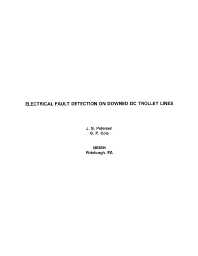Mining Publication: Electrical Fault Detection on Downed DC Trolley Lines
Original creation date: February 1997
The National Institute for Occupational Safety and Health (NIOSH), Pittsburgh Research Center (PRC), has conducted research to improve electrical fault detection on coal mine direct current (dc) trolley systems. Present circuit breaker protection systems are current-magnitude-based and cannot discern between normal traffic and high resistance electrical faults. Tests were conducted at cooperating mines to assist in developing a neural-network-based detection algorithm for distinguishing between electrical faults and normal operation. The Fast Fourier Transform of the trolley rectified current signature served as baseline data for the neural network. During field tests, the algorithm performed with greater than 90% accuracy.
Authors: JS Peterson, GP Cole
Conference Paper - February 1997
NIOSHTIC2 Number: 20021274
SME Preprint 97-38, Society for Mining, Metallurgy, and Exploration, Inc., 1997 Feb:1-5
See Also
- Detection of Downed Trolley Lines Using Arc Signature Analysis
- A Passive Means to Detect Hot Trolley Insulators
- Protecting Miners from Electrical Arcing Injury
- Technology News 439 - Remote Reset Systems for Continuous Mining Machines Used In Extended Cuts
- Technology News 474 - A Passive Means to Detect Hot Trolley Insulators
- Page last reviewed: 9/21/2012
- Page last updated: 9/21/2012
- Content source: National Institute for Occupational Safety and Health, Mining Program


 ShareCompartir
ShareCompartir
